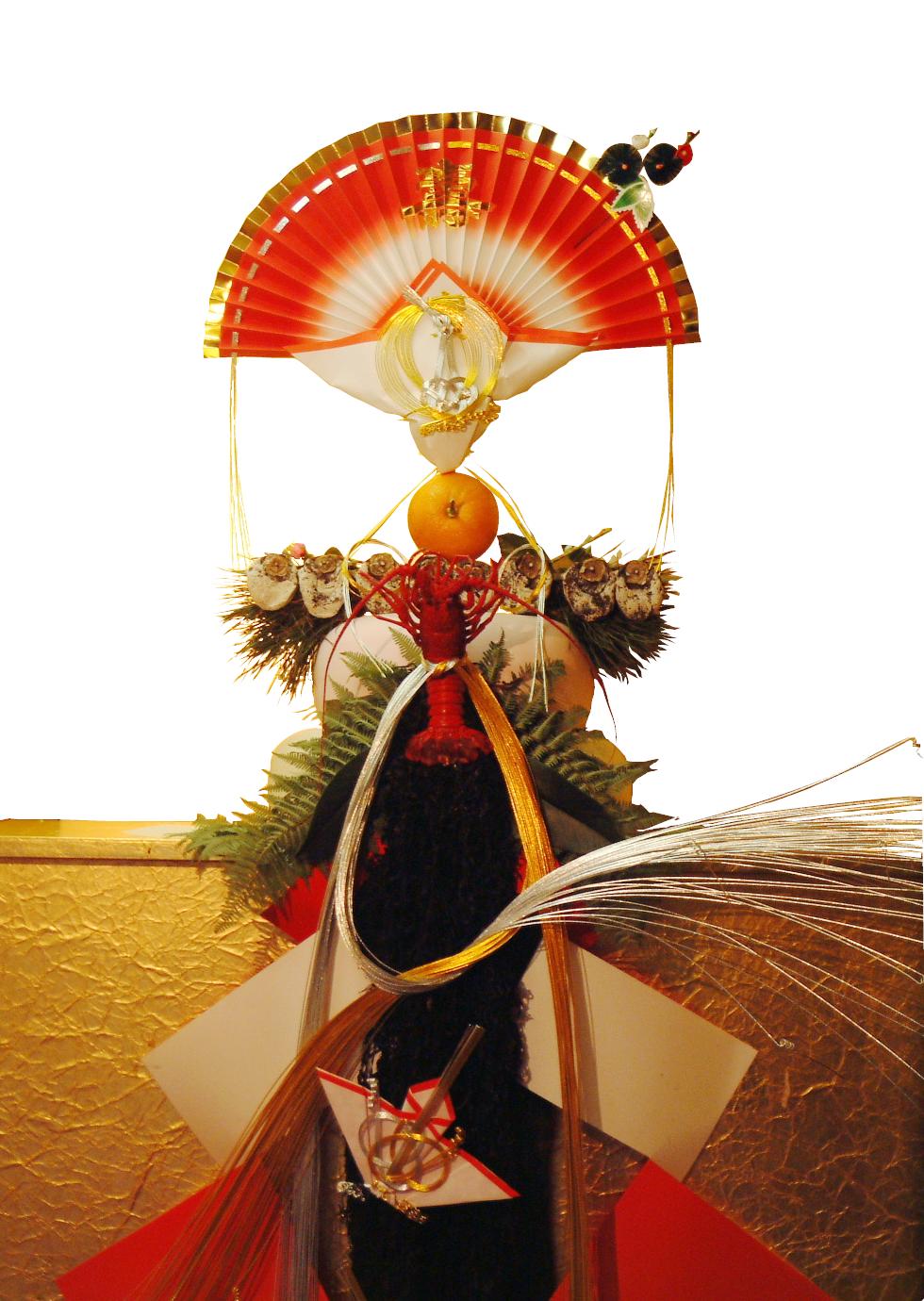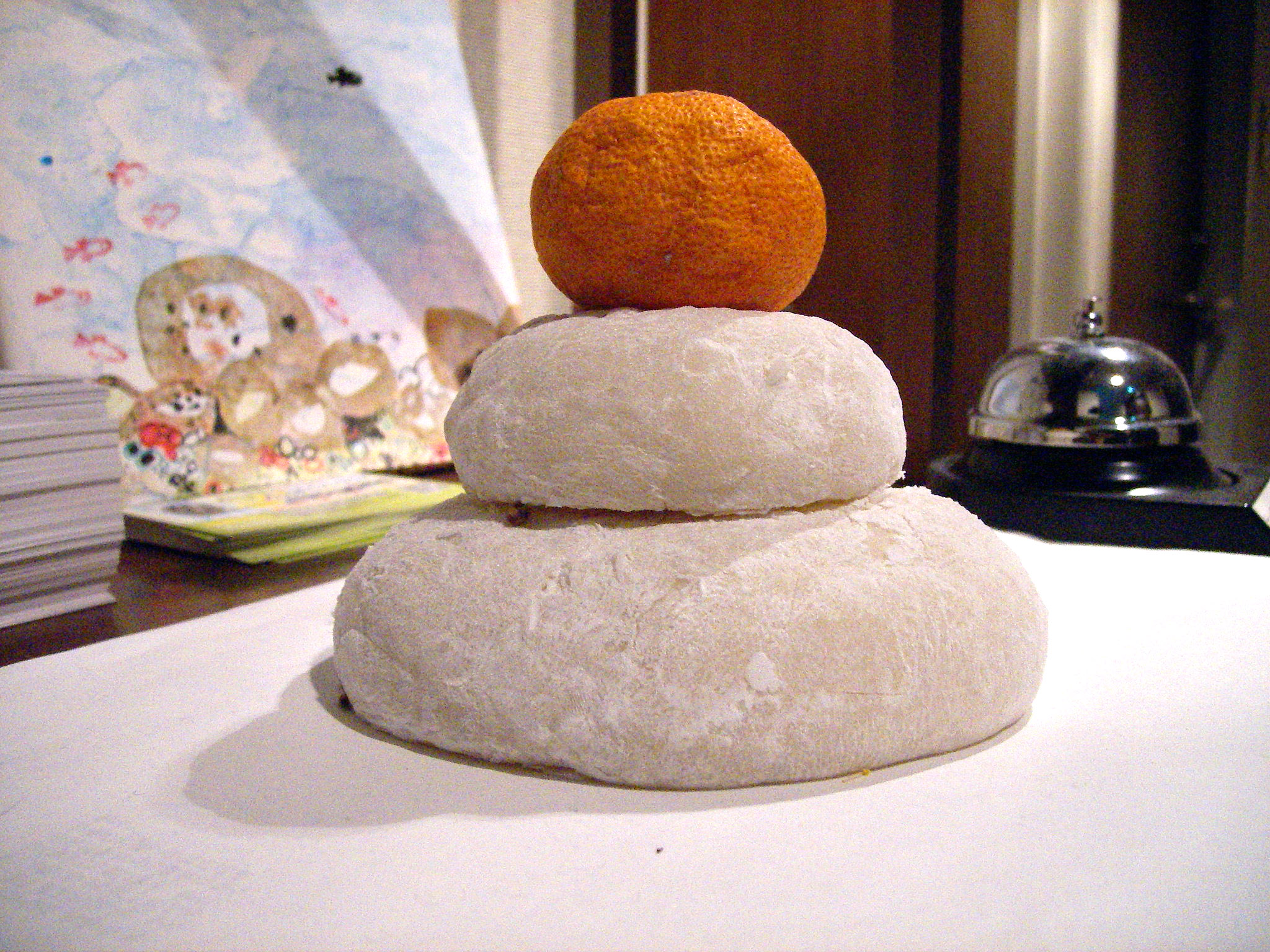Happy New Year to all! In my part of the world it is at least 😄Given that I am a learning Buddhist, this is an important time for me particularly with the advent of a new start, so I will celebrating so this will only at most be a short blog post, I can spend up to 3 days on researching some of these topics after all. As a side note I cannot believe it has been 11 months since I started writing this blog; time goes so quickly as you get older I swear! This time round I thought I would explain some of those New Year decoration pieces you see in Anime released around this time.
すべてに幸せな新年! 世界の私の部分では、少なくとも😄 サイドノートとして, 私はこのブログを書き始めてから11ヶ月が経過しているとは信じられません。 今回は、この頃にリリースされたアニメで見られる新年の装飾作品のいくつかを説明しようと思いました。
Kagami Mochi are a traditional Japanese New Year decoration made of two unequally proportioned round mochi (Rice Buns) stacked on top of each other and a Daidai (a bitter type of orange) atop them with a leaf. Sometimes there is a Konbu (a Sheet) and dried persimmons underneath the Mochi which sits on a Sanpou ( Stand | 三宝) over a Shihōbeni ( Another Sheet | 四方紅) to keep fires away from the house in the coming months. Gohei ( Folded Paper Shinto Strips | 御幣) a type of Shimenawa ( An Enclosing or Boundary Rope | 標縄 or 注連縄 ) are also usually attached, as this is a decorative attachment affiliated with Shinto, which you will often see at Shrines which use these as a way to attain spacial-purity in Shintoism.[1] Other common decorations include Fans, Hemp knots and wrapping decorations made from polychromatic or gold ornamental designs.
鏡餅(かがみもち)は、日本の伝統的な正月飾りで、二つの不均等な比例した丸い餅を重ね、その上に葉を付けた橙(だいだい)を作ったものである。 餅の下には昆布と干し柿があり、それは四方紅の上に三宝(さんぽう)の上に置かれ、今後数ヶ月の間に家から火を遠ざけるために置かれることがあります。 御幣(ごへい)注連縄(しめなわ)の一種で、神道に付随する装飾的な付属品であり、神道の空間的な純度を得るためにこれらを使用する神社でよく見られる。[1]他の共通の装飾は多色か金の装飾用の設計からなされるファン、麻の結び目および包む装飾を含んでいます。
Kagami first appeared in the 1300's CE, with the origins being rather murky, but are thought to relate in some way to the importance mirrors held to Japanese people in these times. Kagami-Biraki as a ritual was begun by Tokugawa Ietsuna ( 徳川 家綱 | 1641-1680) around the Kanbun period (1661-1673 CE) as an auspicious ceremony meant to aid him in victory over his enemies in a coming battle.[2] Around 1884, the practice of Kagami-Mochi began to be used in Judo dojos as a way to celebrate the New Year, spreading later to Aikido, Karate and Jujutsu dojos as well. Mochi are also a traditional form of food in Japan as they are made from a staple food in Japan (rice), and play many roles in other traditional events and days like Hinamatsuri ( The Doll Festival). Traditional Kagami-Mochi were made by hand, but modern versions are sometimes made from plastic moulds, and the Daidai with a Mikan orange.[1]
鏡餅は1300年代に初めて登場し、起源はやや暗いですが、これらの時代に日本人が持っていた鏡の重要性に何らかの形で関連していると考えられています。 鏡開き(かがみびらき)は、寛文年間(1661年-1673年)頃に徳川家綱( Tokugawa Ietsuna |1641年-1680年)によって、来るべき戦いで敵に勝利するための縁起の良い儀式として始められた儀式である。[2]1884年頃、鏡餅の練習は新年を祝うための方法として柔道道場で使用されるようになり、後に合気道、空手、柔術道場にも広がりました。 餅は日本の主食(米)から作られているため、日本の伝統的な食べ物でもあり、ひな祭りなどの伝統的なイベントや日に多くの役割を果たしています。 伝統的な鏡餅は手作業で作られていましたが、現代版はプラスチック製の型とみかんの橙色の台で作られることがあります。[1]
Happy Holidays!
Bibliography | 参考文献の参照
[1] https://en.wikipedia.org/wiki/Kagami_mochi
[2] https://en.wikipedia.org/wiki/Kagami_biraki
Social Links
One stop Link shop: https://linktr.ee/Kaguyaschest
https://www.etsy.com/uk/shop/KaguyasChest?ref=seller-platform-mcnav or https://www.instagram.com/kaguyaschest/ or https://www.youtube.com/channel/UC5APstTPbC9IExwar3ViTZw https://www.pinterest.co.uk/LuckyMangaka/hrh-kit-of-the-suke/




No comments:
Post a Comment